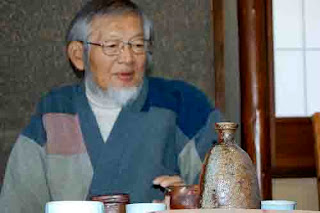In January, several Pennsylvania potters were part of a two week tour of some of Japan. Holly Van Dine and Dennis Bergevin joined a group of sociology and ceramics students which was organized at Washington and Jefferson College.
Harada Shuroku, respected Bizen potter.
Japantrac, a tour firm from State College, organized and expertly led the trip for W & J College ceramics and sociology students. (A few local ceramists also went along.)
Japantrac has led Japan tours for the New York Museum of Modern Art, the Guggenheim Museum and The Japan Society and many others. Their guides provide a depth of cross-cultural understanding and a view of Japan tailored to the interests of the travelers.
On this trip, the group stayed in several Japanese-style hotels featuring tatami floors and guest kimonos and Japanese baths. Ceramics visitors went to the Robert Yellin gallery in Mishima and made a trip to Bizen with Yellin as a guide.
Robert Yellin
Robert Yellin is a leading interpreter of contemporary Japanese ceramics and runs a gallery, the Robert Yellin Yakimono Gallery in Mishima (and also available online).
Pottery from the Yellin Gallery by
Uetake Satoshi
Pottery from the Yellin Gallery by
Tim Rowan of the US.
Pottery from the Yellin Gallery.
Pottery from the Yellin Gallery by
Takeuchi Shingo.
Pottery from the Yellin Gallery.
Shigaraki Jar by Furutani Kazuya.
Pottery from the Yellin Gallery by
Takeuchi Shingo.
Takeuchi Shingo.
Pottery from the Yellin Gallery. Ono Kotaro, white porcelain tea cups.
Bizen is considered Japan’s most popular unglazed pottery, made continuously for over 1000 years. The clay comes from local rice paddies (high iron content) or local mountains (low iron content) and is wood fired for long periods, anywhere from 10 days to three months, since the clay will crack if the kiln temperature rises too fast.
Japanese refer to keshiki, or the landscape of the work. Keshiki are different effects caused by the positioning of the pot in the fire flow and fly ash.
Four of these effects are called: yohen, or highly prized firing mutations; goma, a sesame seed tone from the ash; hidasuki, a fire cord pattern; and sangiri, a charcoal tone.
Bizen pottery.
Bizen pottery.
Bizen pottery.
Bizen pottery.
Bizen pottery.
Robert Yellin offered us this Sixth century BC poem as very much in the spirit of Zen and a yakishime (woodfire) pot:
Pots are made out of clay
But the hollow space in them makes the essence of the pot
And the essence comes from an intangible something
In the spirit of the potter
Which he is able to blend into all his knowledge of the throwing,
The glazing, and the firing
So that every piece from his hand is as much his own signature and his heartbeat
Only then will the pot be good, that is, alive
And the more highly developed a potter is as a human being, the better his pot
For there is no real beauty without character.
Most potters love food so Holly has provided us with a visual sampling.
The Reverend's noodles.
Eel Dinner.
Baby Sardine Dinner.
Prawn Dinner.
At the Sushi-go-round. Holly and Dennis on left.
At the Sushi-go-round.
Dressing up for dinner.
From the Noodle Shop.
Japanese Bakery.
Yogi Dennis.
Calligrapher.
Calligrapher.
Dennis meets the wall.
Holly's room at the Buddhist Complex.
For more information on future tours, you can reach Japantrac at Jonathan Phillippi



























Thanks for the Photo, Beautiful Japanese Art,
ReplyDeleteThere is this Art Gallery Yakimono in Paris, showing nice pieces.
Yakimono Paris